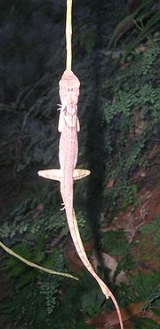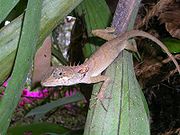
Calotes rouxii
Encyclopedia
Roux's Forest Calotes or Roux's Forest Lizard (Calotes rouxii) is an agamid lizard
found in the Western Ghats
of India
.

 Length of head one and a half times its breadth; snout a little longer than the orbit; forehead concave; cheeks swollen in the adult male: upper head-scales unequal, strongly keeled; canthus rostralis and supraciliary edge sharp; two small separated spines on the back of the head, the anterior mid-way between the nuchal crest and the tympanum, the posterior just above the ears; diameter of the tympanum half that of the orbit; 9 or 10 upper and as many lower labials. Dorsal scales keeled, the upper rows pointing backwards and upwards, the lower backwards and downwards, about as large as the ventrals, which are strongly keeled and mucronate; 50 to 60 scales round the middle of the body: gular sac very small, absent in the female, gular scales smaller than the ventrals; a long, oblique, curved fold in front of the shoulder extending nearly across the throat, covered with small granular scales. Nuchal crest composed of a few slender erect spines, the longest of which is half the diameter of the orbit; dorsal crest a mere denticulation; in the female it is absent. Limbs moderate, slender; fourth finger a little longer than third; fourth toe distinctly longer than third: the hind limb reaches to the temple. Tail feebly compressed; in the fully grown male it is considerably swollen at the base, the scales which cover that part being enlarged and thickened, the median row above largest and forming a serrated ridge. Olive-brown above, the top of the head and vertebral region rather light; a dark band along the side of the head on to the neck; ante-humeral fold black; dark lines radiating from the eye; below light brownish. In life the upper part of the head, nape, and gular pouch may be brick-red.
Length of head one and a half times its breadth; snout a little longer than the orbit; forehead concave; cheeks swollen in the adult male: upper head-scales unequal, strongly keeled; canthus rostralis and supraciliary edge sharp; two small separated spines on the back of the head, the anterior mid-way between the nuchal crest and the tympanum, the posterior just above the ears; diameter of the tympanum half that of the orbit; 9 or 10 upper and as many lower labials. Dorsal scales keeled, the upper rows pointing backwards and upwards, the lower backwards and downwards, about as large as the ventrals, which are strongly keeled and mucronate; 50 to 60 scales round the middle of the body: gular sac very small, absent in the female, gular scales smaller than the ventrals; a long, oblique, curved fold in front of the shoulder extending nearly across the throat, covered with small granular scales. Nuchal crest composed of a few slender erect spines, the longest of which is half the diameter of the orbit; dorsal crest a mere denticulation; in the female it is absent. Limbs moderate, slender; fourth finger a little longer than third; fourth toe distinctly longer than third: the hind limb reaches to the temple. Tail feebly compressed; in the fully grown male it is considerably swollen at the base, the scales which cover that part being enlarged and thickened, the median row above largest and forming a serrated ridge. Olive-brown above, the top of the head and vertebral region rather light; a dark band along the side of the head on to the neck; ante-humeral fold black; dark lines radiating from the eye; below light brownish. In life the upper part of the head, nape, and gular pouch may be brick-red.
From snout to vent 77 ; tail 170 mm.
Range. Bombay Presidency (Matheran, Khandala, Kanara; Jog) ; Travancore. Its habits are terrestrial and arboreal.
Lizard
Lizards are a widespread group of squamate reptiles, with nearly 3800 species, ranging across all continents except Antarctica as well as most oceanic island chains...
found in the Western Ghats
Western Ghats
The Western Ghats, Western Ghauts or the Sahyādri is a mountain range along the western side of India. It runs north to south along the western edge of the Deccan Plateau, and separates the plateau from a narrow coastal plain along the Arabian Sea. The Western Ghats block rainfall to the Deccan...
of India
India
India , officially the Republic of India , is a country in South Asia. It is the seventh-largest country by geographical area, the second-most populous country with over 1.2 billion people, and the most populous democracy in the world...
.
Description
From C. A. L. Gunther (1864) The Reptiles of British India.
Two small groups of spines, separated from each other, on each side of the neck. A fold in front of the shoulder. Tail compressed into a sharpish edge at its base, covered superiorly with very large pentagonal scales. Scales on the sides of the body nearly as large as those on the belly. Tail below with four longitudinal series of rhomboid, strongly keeled scales, each terminating in a point posteriorly. Brownish, uniform or spotted with black.
The exact locality whence this species has been obtained is not known, nor has the species ever been identified by more recent observers. Jerdon enumerates a C. rouxii in his list of the Reptiles of Southern India (Journ. As. Soc. Beng. xxii. p. 471); having seen a rough figure of this species in the collection of drawings in the possession of W. Elliott, Esq., I have come to the conclusion that this must be an undescribed species, having a pair of isolated spines immediately behind the orbit and a black fold of the skin before each shoulder. The male is represented as uniform blackish brown, with yellow head and neck; the female brown, with irregular dark cross bands. I propose for this species the name of C. elliotti.
Mr. Blyth also has a C. rouxi from Birma and Ceylon; but this determination is as incorrect as that by Mr. Jerdon, the lizard in question having a row of three or four spines above the tympanum (see C. nigrilabris).

From snout to vent 77 ; tail 170 mm.
Range. Bombay Presidency (Matheran, Khandala, Kanara; Jog) ; Travancore. Its habits are terrestrial and arboreal.

